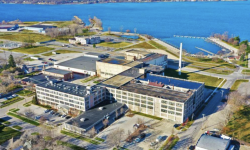Opinion | State policy leaders: Consider this when crafting final 2021 budget
Gov. Gretchen Whitmer and state legislative leaders have until the end of this month to fulfill their state constitutional obligation to pass a budget for the next fiscal year, which begins Oct. 1.
Based on two decades’ worth of past experience, Michigan’s public university leaders are once again cringing at the prospect of having the state’s budget shortfalls laid at the feet of these institutions and the students and families they serve, this time due to COVID-19 related revenue impacts.
While the outcomes of the recent Consensus Revenue Estimating Conference were much better than expected—with considerably larger revenue figures courtesy of the CARES Act federal stimulus and other drivers—the state still faces a $385M budget hole for the coming fiscal year.
From every vantage point, higher education has been a go-to source for the state when it comes time to cut its budget. The result: a state that stands out for its dismal investment in our workforce, and in our state’s economy. We simply cannot afford to continue to have higher education serve as the balancing wheel of the state budget, in which investments are made in every other aspect of state government, to the detriment of Michigan’s public universities and the 280,000 students they educate annually. Not only has this state disinvestment been detrimental to the state’s competitiveness, it’s counter to good conservative fiscal policy.
As state leaders appropriately ask critical questions to inform their budgetary decision-making, I ask that they keep the following considerations in mind as it involves the state’s investment in higher education.

The pandemic has demonstrated the value of a college degree, which was already high.
Higher educational attainment leads to much greater job mobility and flexibility. Those with a college degree have been more likely to be able to work from home, continue to earn a salary, and create value for their employers and tax revenue for the state. A national study reviewed by the U.S. Bureau of Labor Statistics showed that 67.5 percent of workers with a bachelor’s degree or higher had an ability to telework, compared to 36.4 percent of those with some college or an associate’s degree, and just 24.5 percent of those with a high school diploma. Meanwhile, national data once again demonstrate the strong correlation between job security and educational attainment, with those possessing a four-year degree or higher being much less likely to be unemployed due to the pandemic’s economic repercussions.
Higher education is a key part of state infrastructure. Cutting state support for higher education now would damage the state (and its workers) for a generation.
Further cuts to higher education will likely lead to higher tuition and make it more difficult for working- and middle-class students to attend college. It will make Michigan even less able to compete for employers who need college graduates and in turn exacerbate the problems of rural and urban poverty in our state. The State of Michigan “Hot 50” forecast of good paying, high demand occupations shows that 38 of them require a college degree. And the number of workers expected to be needed in careers requiring a degree is much higher—as are their expected earnings.
Universities have faced new costs to continue operations through the pandemic.
No university closed during the pandemic, while most operations were moved online. That was an expense as universities needed to invest more in their I.T. infrastructure, in software for instruction, and technology for students to learn away from campus. As universities have prepared for in-person instruction, they have incurred added costs for PPE and other safety measures such as installing Plexiglas barriers, opening larger classroom facilities, and intensive cleaning and sanitizing protocols. Room and board refunds were issued in the spring, and housing and dining operations that remain open now have to be less efficient in the name of safety. A conservative estimate of pandemic-related financial impacts on the state universities collectively tops $1 billion.
Approaches to instructional delivery matter. Online education is not a money saver.
Michigan’s public universities are doing what is best for their students. Students have diverse needs for learning, requiring universities to provide access to both in-person and online educational opportunities. Having to offer both options to meet the needs of students and their families is an additional expense, not a cost savings.
Most universities do not have significant endowments. The vast proportion of endowment assets are restricted in their use, just as state lawmakers can’t use gasoline tax revenue for higher education.
Most of our 15 public universities have small endowments, and all endowments are largely contractually restricted for specific purposes, such as for scholarships or endowed chairs, as dictated by donors. Many of the universities have conducted supplemental fundraising campaigns in recent months to generate emergency grants for students in need, and they continue to invest mightily in need-based financial aid to keep the net price of attending college affordable for lower income students.
State revenue fell while tuition revenue fell.
A key driver of university revenue shortfalls is declining enrollment, as some students stay home in uncertain times. International students are also unable to return to the U.S. and some out-of-state students are unable or unwilling to return to campus. Those students often pay substantially more in tuition, subsidizing Michigan resident students.
Higher education has already been cut repeatedly; there’s nothing left to give.
State support for public universities and financial aid today is $1 billion below the 2002 level when inflation adjusted. The universities continue to implement operational efficiencies and reduce expenses where feasible and appropriate across the campus enterprise. Layoffs and cuts this year alone at the universities have been significant. Still, the state-to-student cost shift in paying for a Michigan public university education continues to grow.
It’s raining—and it’s time to use the Budget Stabilization Fund.
The evidence is clear that we are in a short-term crisis—exactly the kind of event the Rainy Day Fund was developed to meet. As the economy rebounds (Michigan in July had an unemployment rate below the national average), stronger revenue will return and the BSF can be replenished. Let’s use it now to ensure we do not undermine the quality of our higher education institutions—a key part of our state’s economic infrastructure.
Our state lawmakers are bestowed with the ability to enact policy that can change lives. No action reflects their policy priorities more than the annual state budget. As productive state assets and the engines of opportunity, I hope that our political leaders will put forth a policy of investment in our state’s future and its workforce, and thus in its public universities, as they craft the final budget in the coming days and weeks.
See what new members are saying about why they donated to Bridge Michigan:
- “In order for this information to be accurate and unbiased it must be underwritten by its readers, not by special interests.” - Larry S.
- “Not many other media sources report on the topics Bridge does.” - Susan B.
- “Your journalism is outstanding and rare these days.” - Mark S.
If you want to ensure the future of nonpartisan, nonprofit Michigan journalism, please become a member today. You, too, will be asked why you donated and maybe we'll feature your quote next time!




